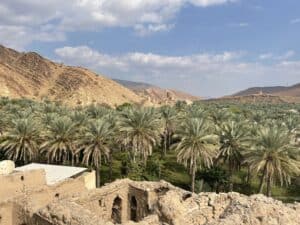

Often overlooked by travellers, Bahla is well-worth a visit. This oasis town is famous for its UNESCO-listed fort, exquisite pottery, and mysterious legends of magic.
This step-by-step guide to Bahla (بهلاء) in Oman sets out the main things to do in a town steeped in history and culture. The Bahla Fort, ancient city walls, and life-giving falaj form an outstanding example of a fortified oasis city from the medieval Islamic period.
Nearest City | Nizwa (~40 km / 30-40 minutes drive) |
Distance from Muscat | ~200 km (1 hour 45 minutes drive) |
Key Attractions | Bahla Fort , Falaj System, Traditional Pottery Workshops, Ancient City Walls |
Best Time to Visit | November to March (for cooler temperatures) |
Recommended Cafe & Inn | Kamakan Heritage Cafe & Inn |
Local Tip | Wear comfortable shoes; the fort steps are uneven. |

“You know how he came, teacher? He just drew a line on the floor and crossed it! People in Bahla can fly and go wherever they want this way!”
I had only been teaching in Nizwa for a month… and already I’d heard about the “special powers” of Bahla’s inhabitants.
Bahla, often known as the ‘City of Magic’, is nestled in the heart of Oman, about 40 kilometres away from Nizwa. It is actually situated in the Ad Dakhiliyah Governorate, lying at the foot of the Jebel Akhdar mountain range.
The time I spent with people from there allowed me to see that Bahla is much more than a story about magic. It’s a collection of stories born out of the will to thrive in a harsh environment and overcome historical threats.

You can easily reach Bahla by car and it makes a good day trip from both Muscat and Nizwa.
From Muscat: it takes around 1 hour 45 minutes (about 200 km) along Route 21. The road runs past Bidbid and Izki before continuing towards Nizwa and then Bahla. The good news is that the road is fully paved and, after extensive works, is now in good condition most of the way.
From Nizwa: it’s a short 30–40 minute drive (around 40 km), and you don’t need a 4×4.
There are no direct public buses to Bahla, but you can take a Mwasalat bus from Muscat to Nizwa and then a taxi to Bahla.
Most travellers prefer renting a car because it gives more flexibility to also visit nearby places like Jabrin Castle, Misfat al Abriyeen, or Al Hamra on the same trip.
Parking is available next to the fort, and from there you can easily walk to the old souq and pottery workshops.
The best time to go is between October and March – and preferably morning or late afternoon as you will be able to walk around and climb up and down in the Fort with ease.

My visit to Bahla began with my hosts offering me a warm welcome with the familiar spread of dates, cardamom coffee, and fruit in their majlis. As we all sat on the carpet, I tried (and failed) to fold myself into the traditional cross-legged position like everyone else.
I loved the dates — three kinds, each with a different texture. I particularly liked the salty-sweet surprise when dipping them into tahina, the sesame paste that’s often served alongside. It’s such a simple combination, yet it connects with an intrinsic part of Omani culture – dates and palm trees.

A walk through Bahla’s lush farms will reveal to you what has always really mattered here: water. In a place surrounded by desert, this is the true treasure.
And, just like in Birkat al Mouz (another beautiful place to visit!), one of the most ingenious ways people here have learned to share and protect it is the falaj. The falaj is an irrigation system that goes back centuries and is still running today. Its intricate engineering even allows the water to run upwards at certain points!
My hosts explain to me in great detail how the falaj is managed by the Falaj Committee in the community. The inhabitants bid for ‘time shares’ (a number of hours) of access to water in a complex auction system. The price rises and falls depending on the season and the rain fall.



When I visited Bahla, I went to the Fort later in the afternoon, around 4 pm. By then, the sun was lower, and the heat was easier to handle. From the parking area, it is only a short walk to the main entrance of the fort.
In 1987, Bahla Fort became the first site in Oman to be recognised by UNESCO for its cultural and historical value. It was constructed by the Banu Nebhan tribe, who ruled the area from around the mid-1100s to the 1400s. Its massive scale clearly reflects their influence.
In fact, it is huge and simple in the best way. No fixed path — just stone walls, staircases, watchtowers, and views. You are free to explore at your own pace. The steps are uneven in places, so comfortable shoes are a good idea.
From the top, you can see the palm trees, the old mudbrick houses, and the mountains in the distance. It gives you a clear sense of how people once watched over and protected the town.
Opening Hours: In general, it is open from 8.00 a.m to 7.00 p.m. This may vary seasonally.
Cultural Note/Story: It is a popular belief among some Omanis that the Bahla Fort is a ‘haunted location’ and is home to a jinn. This is part of the local folklore that has earned Bahla the nickname ‘City of Magic.’ During my visit, we saw some bats that – eerily – only huddled around the prison, adding to the mysterious atmosphere.




Right next to the Fort, up a dirt road, you will find a beautiful heritage cafe: Kamakan. Its adobe walls, orginal ceiling, and wide-ranging views over the town and the fort make this a great place to relax and cool down. I particularly recommend their cold ginger drink. It’s one of their best sellers – and I understand why!

I was amazed to discover that the old city walls around Bahla extended 13 kilometres! As we arrived at the remains of one of the gates, some people rode past on horses as the sun set.
The walls, the Fort, even the stories of magical powers all made me reflect on the need for Bahla’s inhabitants to protect themselves throughout history. I could see how their water supplies and rich vegetation would attract invaders.
Local Legend: One of the most famous legends connected with these walls is the belief that they were built in a single night. The story goes that two sisters, Maitha and Gaitha, used their magical skills to conjure jinn, who then built the defensive walls to protect the town.


Mid-range: Kamakan Inn. As well as its Cafe (see above), I also recommend the inn that is connected. It is small, ideally located next to the Fort and near the Souq. ‘Kamakan’ used to be a group of mud-brick homes and was restored using the same traditional materials. In fact, its name means ‘as it was’.

A Wahat Al Tabiya TRAD. Restaurant. offers local Omani and Indian dishes in a setting that honours heritage. The menu includes Biryani, Kabsa, tandoori, and a variety of sandwiches.
Bahla is a place that stays with you. It offers so much history and culture in one small town — the fort, the pottery workshops, the old souq, the farms, and the ingenious falaj that still feeds life into the oasis.
Speaking with my hosts and friends from Bahla helped me understand how much thought and cooperation lie behind all this.
It also opened a door into the town’s many stories about the unseen. Bahla’s connection to magic remains mysterious to me, but I do know this: the real magic I found there was in the kindness of its people.

Hi, I’m Christine. I’ve lived in Oman for over four years and spent that time travelling across the country - from desert camps to remote mountain villages. Joussour to Oman is where I share practical guides and honest tips for experiencing Omani culture, nature, and daily life. This list is based entirely on places I’ve visited myself - often more than once.
One Response